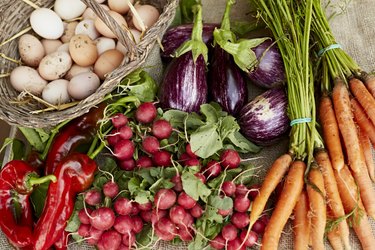
Excess fat on your chest and abs not only obscures your six-pack, but it may pose a serious health risk. An ample abdomen is a symptom of excess visceral fat pushing outward against the layer of squishy subcutaneous fat just under the skin. Visceral fat surrounds the organs deep in your abdominal cavity and it increases your risk of chronic diseases, such as heart disease. You won't be able to lose fat solely from your chest and abdomen during weight loss, but reducing your overall fat levels will burn the fat on these areas of your body, too. Use a calorie calculator app to formulate a diet and exercise plan to help you reach your goals.
Tip
Excess chest and abdominal fat can pose a serious risk to your health, but you can melt that fat away using a combination of healthy eating choices — more veggies, please! — and increased physical activity.
Video of the Day
Cut Calories for Fat Loss
Losing any fat, including chest and abdominal, requires burning more calories than you eat. This creates a calorie deficit, so your body turns to internal fat stores as a source of energy and lowers your overall fat levels. Lose weight at a safe rate by creating a daily calorie deficit of 500 to 1,000 calories — that's enough to lose 1 to 2 pounds of fat weekly.
Video of the Day
The exact number of calories you'll need to lose weight depends on your activity level, gender, age and body composition, and a nutrition professional or online calorie calculator can help you figure it out. In general, Harvard Health Publishing notes that men should never dip below 1,500 calories daily, and women should never eat less than 1,200 to 1,500 calories, without guidance from a medical professional.
Healthy Grains, Fats and Protein
Most of your daily calories should come from minimally processed foods, with a focus on fruits and vegetables, whole grains, lean proteins and healthy fats. While, technically, creating a calorie deficit using any food will help you lose weight, you'll need a healthy diet to provide nutrients to feel and look your best as you lose weight, as well as avoid harmful nutritional deficiencies.
Substitute whole grains — like whole-wheat bread or pasta, brown rice or quinoa — in place of refined grains, like white bread, and look to olive oil, nuts, seeds and avocado as sources of fat, instead of fried foods, butter and fatty dairy products, which contain unhealthy saturated fats. Eat lean proteins like fish, poultry, beans, eggs and low-fat dairy instead of fattier options, like processed red meats. Leaner protein also tends to be lower in calories; a roasted chicken breast, for example, has 165 calories, compared to 250 calories in a strip steak.
Read more: Meal Plan to Lose Belly Fat
Eat More Vegetables
Simply eating more veggies may help you stick to a weight-loss diet, according to a 2014 study published in the European Journal of Clinical Nutrition. Researchers studied 120 overweight adults over the course of one year as they dieted to lose weight. One group simply followed a restricted-calorie diet designed to allow weight loss; the other followed the restricted-calorie diet but also doubled portion size any time they ate vegetables. The double-veggie group lost more weight in the short term, and, not surprisingly, they reported feeling less hungry over the 12-month study period compared to the group that simply ate fewer calories.
Up your veggie intake by starting each meal with a serving of veggies — whether a small pureed vegetable soup, a few carrot and celery sticks or a leafy green salad. Blend a few handfuls of leafy greens into your protein shakes, and add roasted vegetables to your tomato sauce when you serve pasta. Invest in a spiral cutter and food processor to eat more veggies: try mixing spiral-cut zucchini with real spaghetti, and make cauliflower "rice" in a food processor to mix with real rice in stir-fries.
Mixing vegetables into your favorite comfort foods can also lower your calorie intake — the low-calorie veggies will take up "space" in the serving size, so you're eating a smaller amount of high-calorie ingredients per portion. Try adding fresh chopped spinach and tomatoes to mac and cheese, and using lower-fat dairy products; if you maintain the same portion size, you could save more than 200 calories.
Read more: How to Tone Your Chest and Stomach
Work Your Chest and Abdominals
You'll get the best results if you pair your weight-loss diet with an exercise routine. Physical activity helps you burn more calories — so it's easier to create a calorie deficit for fat loss — and helps strengthen your muscles so that when you do lose the weight, you'll look more toned and fit. Health.gov's Dietary Guidelines for Americans recommends at least 75 minutes of vigorous-intensity aerobic exercise or 150 minutes of moderate-intensity cardio each week.
Build up your chest and abdominal muscles with strength training. Pushups, flies and rows work your upper body, including your chest and back, and engage your abs to tone your midsection, while planks and wood chops directly target your abdominal muscles.
- Harvard Health Publishing: "Abdominal Fat and What to Do About It"
- Centers for Disease Control and Prevention: "Healthy Eating for a Healthy Weight"
- Health.gov: "Dietary Guidelines for Americans: Appendix 1. Physical Activity Guidelines for Americans"
- European Journal of Clinical Nutrition: "Weight Loss Effects From Vegetable Intake: A 12-Month Randomised Controlled Trial"
- MyFoodData: "Nutrition Comparison of Roasted Chicken Breast and Lean Grass Fed Beef Strip Steak"
- Harvard Health Publishing: "Calorie Counting Made Easy"